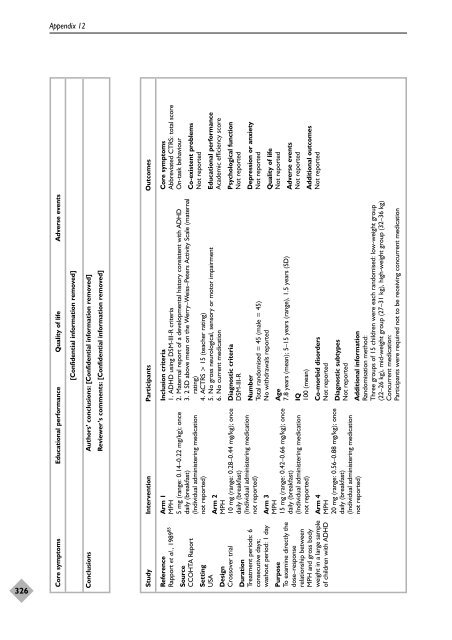APPENDICES. A systematic review and economic model of the ...
APPENDICES. A systematic review and economic model of the ...
APPENDICES. A systematic review and economic model of the ...
You also want an ePaper? Increase the reach of your titles
YUMPU automatically turns print PDFs into web optimized ePapers that Google loves.
326<br />
Appendix 12<br />
Core symptoms Educational performance Quality <strong>of</strong> life Adverse events<br />
[Confidential information removed]<br />
Conclusions Authors’ conclusions: [Confidential information removed]<br />
Reviewer’s comments: [Confidential information removed]<br />
Study Intervention Participants Outcomes<br />
Core symptoms<br />
Abbreviated CTRS: total score<br />
On-task behaviour<br />
Reference<br />
Rapport et al., 1989 85<br />
Co-existent problems<br />
Not reported<br />
Arm 1<br />
MPH<br />
5 mg (range: 0.14–0.22 mg/kg); once<br />
daily (breakfast)<br />
(Individual administering medication<br />
not reported)<br />
Source<br />
CCOHTA Report<br />
Educational performance<br />
Academic efficiency score<br />
Inclusion criteria<br />
1. ADHD using DSM-III-R criteria<br />
2. Maternal report <strong>of</strong> a developmental history consistent with ADHD<br />
3. 2 SD above mean on <strong>the</strong> Werry–Weiss–Peters Activity Scale (maternal<br />
rating)<br />
4. ACTRS > 15 (teacher rating)<br />
5. No gross neurological, sensory or motor impairment<br />
6. No current medication<br />
Setting<br />
USA<br />
Psychological function<br />
Not reported<br />
Arm 2<br />
MPH<br />
10 mg (range: 0.28–0.44 mg/kg); once<br />
daily (breakfast)<br />
(Individual administering medication<br />
not reported)<br />
Design<br />
Crossover trial<br />
Diagnostic criteria<br />
DSM-III-R<br />
Depression or anxiety<br />
Not reported<br />
Number<br />
Total r<strong>and</strong>omised = 45 (male = 45)<br />
No withdrawals reported<br />
Quality <strong>of</strong> life<br />
Not reported<br />
Age<br />
7.8 years (mean); 5–15 years (range), 1.5 years (SD)<br />
Adverse events<br />
Not reported<br />
IQ<br />
100 (mean)<br />
Arm 3<br />
MPH<br />
15 mg (range: 0.42–0.66 mg/kg); once<br />
daily (breakfast)<br />
(Individual administering medication<br />
not reported)<br />
Additional outcomes<br />
Not reported<br />
Co-morbid disorders<br />
Not reported<br />
Duration<br />
Treatment periods: 6<br />
consecutive days;<br />
washout period: 1 day<br />
Purpose<br />
To examine directly <strong>the</strong><br />
dose–response<br />
relationship between<br />
MPH <strong>and</strong> gross body<br />
weight in a large sample<br />
<strong>of</strong> children with ADHD<br />
Diagnostic subtypes<br />
Not reported<br />
Arm 4<br />
MPH<br />
20 mg (range: 0.56–0.88 mg/kg); once<br />
daily (breakfast)<br />
(Individual administering medication<br />
not reported)<br />
Additional information<br />
R<strong>and</strong>omisation method:<br />
Three groups <strong>of</strong> 15 children were each r<strong>and</strong>omised: low-weight group<br />
(22–26 kg), mid-weight group (27–31 kg), high-weight group (32–36 kg)<br />
Concurrent medication:<br />
Participants were required not to be receiving concurrent medication
















